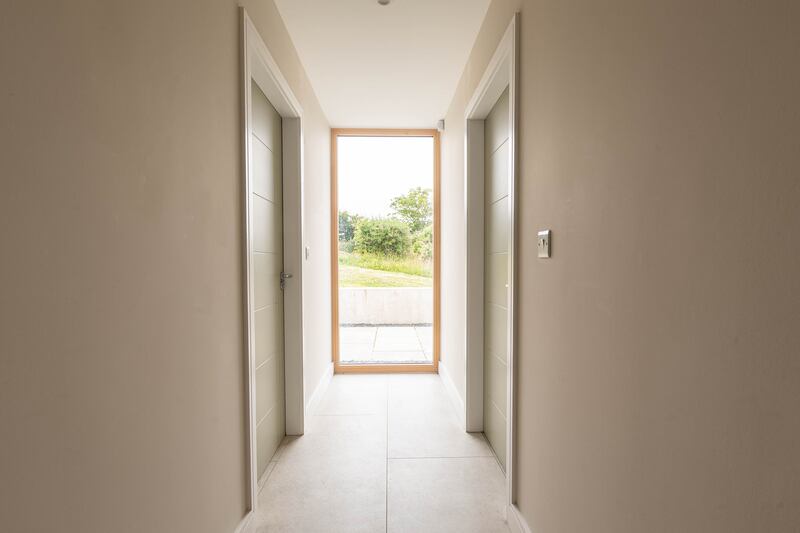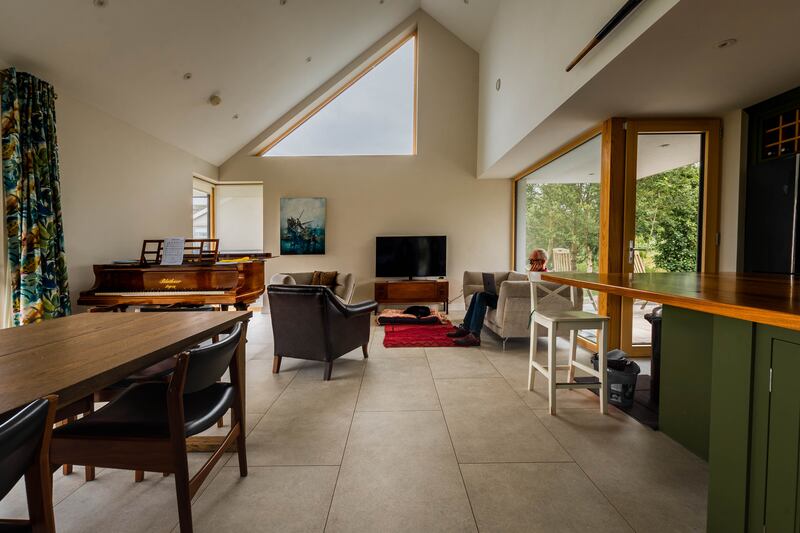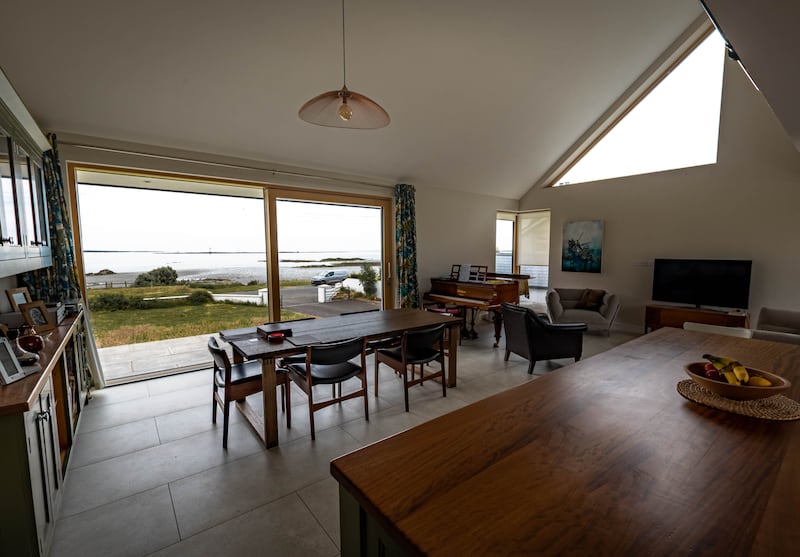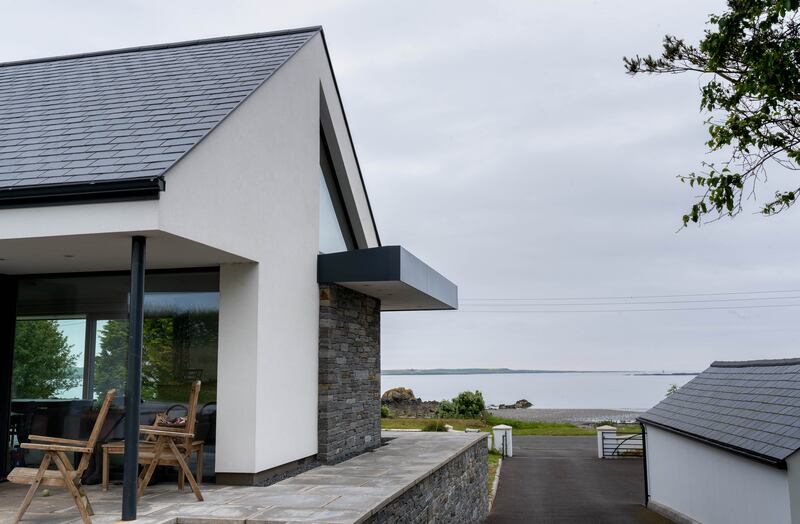As the summer ends, the reality of rising energy costs is beginning to hit home and many people will be dreading the dip in temperatures as they try to keep warm in the coming months.
But some people were fortunate enough to have planned ahead, ensuring their house is as energy efficient as possible.
Rory and Natalie Reilly started their passive home project back in 2014.
After searching for the perfect place for their project, the couple finally bought the strategically located site located at the mouth of Strangford Lough in Co Down, and began the transformation, which, they admit, took some research.
READ MORE
“We moved to the Strangford area in 2014 hoping to find a site or derelict house which could be replaced with a net-zero-energy or passive house,” says Rory. “This was an ambition of mine for many years and although we originally got bogged down with another purchase which eventually went nowhere, we then settled on the current site which we had also seen during our original search — and getting planning permission for an infill property enabled us to build in what is a stunning location.


“The next step was to find an innovative firm of architects who were building a reputation, and 2020 Architects in Ballymoney seemed to fit the bill. Some friends of ours were building a passive house in Strangford, so we were able to watch local firm O’Prey Developments (to see how they worked), taking all the care to learn and (later) apply the techniques needed for that type of build. We decided to contract the same firm to build ours, and to project manage the whole process from start to finish — as living next door meant that we could be involved on a daily basis without having the stress of organising any aspect of the build.
“Although much of the original brief was on the technical side, Natalie’s 1902 Bluthner grand piano (a classically trained pianist she now just plays for fun) had to be taken into account, as had the views out to the lighthouse on Angus Rock.”
The couple, who, together with Rory’s daughter Emily, run Reilly Education, an international educational consultancy, got planning permission for their build in 2017 and started work the following spring.
“Planning did lead to some compromises but completion was set for Easter 2020,” says Rory. “In the end it was delayed by three or four months due to the first Covid lockdown — as luckily, unlike [how it always appears to be on TV] Grand Designs, we didn’t have to get out of our house, no one was ill or pregnant and while we did run in budget that wasn’t disastrous.
“The cost was much in line with expectations — homebuilding.co.uk suggested €1,448-€2,028 per sq m (£1,250-£1,750) and ours just about fitted into that bracket. It could have been cheaper if we hadn’t decided to build on a sandy slope or if we had opted for no steel or perhaps used less expensive windows — which are floor to ceiling, triple-glazed and Passive House certified.
“Also, building on a slope is always an issue but building on a combination of slope and sand results in rather serious and expensive foundations. But now, sitting on top of these is our three-bedroomed 200sq m house, which includes an upstairs office, and high-speed broadband with Zoom connectivity to the rest of the world.”
For an ex-elite rower, the location of the house is perfect as Rory now spends his time coaching juniors at the Strangford Coastal Rowing Club, where Natalie is chair and their children Sally and Christopher also participate. And it also affords the family a spectacular view.
“We wake to the beautiful view across the mouth of Strangford Lough and the Ards peninsula to the Isle of Man,” says Rory. “It is a view which is always changing — with everything from tall ships, yachts and fishing boats to those amazing blue-grey days when you can’t differentiate between the sea and the clouds. The beach is right in front of the house with access to walks across rocky shorelines and salt marshes — snipe, migrating geese, herons, seals and even orcas have all been spotted and our black cocker spaniel, Luna, loves it.
“The garden is a mix of rock and the soft sand of a late Ice Age raised beach — and stable yard manure, mushroom compost and seaweed provide nourishment for a vegetable garden with much of the rest being developed as a “coastal meadow” — or in other words, I let it grow wild.
“We are really pleased with the end result. We are still learning how to get the best use out of the combination of solar panels, air source heat pump, mechanical ventilation and heat recovery, as with a super-insulated house, this takes a bit of time. But as we move towards this winter of huge energy costs, it is comforting to know that we can keep our external energy demand to a minimum and yet have a home that retains heat, has no draughts and has a constant supply of fresh air.
“And apart from all of that, the views are stunning and that is definitely good for the soul.”
The house is also delivering cost savings. According to price comparison site Selectra, for example, the average energy cost for a three- or four-bedroom house in Ireland is more than €3,000 a year — and this is set to jump substantially come October.
The Reilly’s electricity bill for the past three months has been €95 (£82) a month (including all charging for an electric car) and €122 (£105) a month for the past six months, so less than €1,500 a year.
“I suspect the cost of refuelling a car is much greater than that for most people. We have no oil, gas or wood fuel bills, only electric, so we are certainly saving more than 50 per cent on the house energy cost. Our costs could be even lower if we cooked less or if the kids spent less time in the shower. In the summer, when Natalie isn’t teaching, we can also use surplus daytime electricity from the solar panels to charge the car (for free),” says Rory.


Tips for success
For anyone thinking of making their home more energy efficient, the father-of-three says the key is to have “wraparound insulation with no gaps and no cold bridges”.
“After that they [passive homes] need to be airtight [with every joint taped or sealed] with a mechanical ventilation and heat recovery system bringing fresh warmed air into the house,” he says. “The warmth comes from a heat exchanger, so the heat from the outgoing stale air is transferred to the incoming fresh air — once this is in place you will have a low-energy home and you can then decide on what extra heat you might like to have, what appliances will work best for you, and whether or not you will have solar panels, battery, heat pump and so on.
“I think my strongest advice would be to those who are building a new house but not considering going down the net-zero or low-energy route. Because in my view, net zero energy should be a starting point to any new build and I find it extraordinary that new houses are being built right now which are going to be energy-hungry, costly to heat and to run, and will probably need to be retrofitted at some point, at a much higher cost.
“We wanted a house which was genuinely sustainable and affordable — and while, yes there are some frills, such as the Irish elm timber floors in the bedrooms and stairs and the vaulted ceiling of the livingroom, essentially our home is a simple design and a straightforward concept — so it should not be seen as some sort of future build. Houses like this should be the norm but until building regulations change I fear they won’t be.”
Reilly says that anyone who is thinking of building a sustainable or passive house, should do their homework first and make sure to get as much information as possible before deciding on who to engage to undertake the work.
“To anyone considering a build like this, I would advise them to talk to those of us who live in these houses,” he says. “Also, there are some wonderful examples being built at the moment and the combination of Google and YouTube will get you started. And in terms of the actual build and what to include, I would say, question everything. You may like to have all of the latest (and expensive) technologies but you might also find you don’t need them. Also, it’s good to note that net zero energy does not mean zero cost. Yes we export electricity back to the grid in the summer but we also have to import it during the winter and of course the feed-in tariff back to the grid is a lot lower.
“One waste of money as far as we are concerned is the cabling, which runs throughout the house, as the wifi is so good that we simply don’t use the hardwire connections — also, the radiators which we put in the bedrooms are completely redundant. But we do like the warm towel rails in the bathrooms.
“And lastly, good aftercare is important with any build and O’Preys have been more than happy to come back and fix anything from door locks to a sliding door or a crack in the render.”













